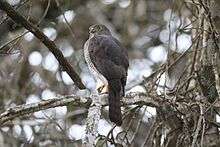Madagascan sparrowhawk
| Madagascan sparrowhawk | |
|---|---|
 | |
| Scientific classification | |
| Kingdom: | Animalia |
| Phylum: | Chordata |
| Class: | Aves |
| Order: | Accipitriformes |
| Family: | Accipitridae |
| Genus: | Accipiter |
| Species: | A. madagascariensis |
| Binomial name | |
| Accipiter madagascariensis Smith, 1834 | |
The Madagascan Sparrow-Hawk or in its latin name the Accipiter madagascariensis) is a bird of prey in the Accipitridae family and are a native specie to Madagascar.
Appearance
A medium-sized forest accipiter. Has a stripped grey and white underbelly and its back is a greyish-blue and black though it may appear blue at times the wings are short-rounded. The throat is finely with streaked a blackish colour, the undertail is white. The eyes and legs are an yellow colour the toes are very long and the bird has a short rounded bill. Young have a brown back and the underbelly is spotted grey. Males are much smaller than females with females being around 29 – 42 cm and 285 – 348g with a wingspan 50–69 cm and males being around half of that.
Diet
The Madagascan Sparrow-Hawks feed largely on small birds and insects which it catches mainly on the wing as well as frogs, toads, rodents and reptiles which are caught on the ground
Habitat and Habits
It is Endemic to Madagascar. Its natural habitats are subtropical or tropical dry forests, subtropical or tropical moist lowland forests, subtropical or tropical moist montane forests, dry savanna, and subtropical or tropical dry shrub-land. The birds fly low through the trees and perch on branches, concealing themselves in the foliage. The sparrow-hawk favours dense forests.
Reproduction
The birds build a flat-stick nest in the fork of a large tree lined with fine twigs and flecks down on the edge. It is measured to be 50mm wide and 250mm deep, the average clutch size is around 2-4. The eggs white and are blunt on the end with a few irregular brown markings covering the egg. The eggs average size is around 38.0 x 33.0 - 35.0 - 30.0
Threats
Currently the population of these birds is very stable lying at around 50,000-70,000 individuals. But due to de-forestation the future of these birds is uncertain.
References
- ↑ BirdLife International (2012). "Accipiter madagascariensis". IUCN Red List of Threatened Species. Version 2013.2. International Union for Conservation of Nature. Retrieved 26 November 2013.
- Ferguson-Lees, James and David A. Christie (2001) Raptors of the World. Christopher Helm, London. pp. 578–581. ISBN 0-7136-8026-1
- http://www.globalraptors.org/
